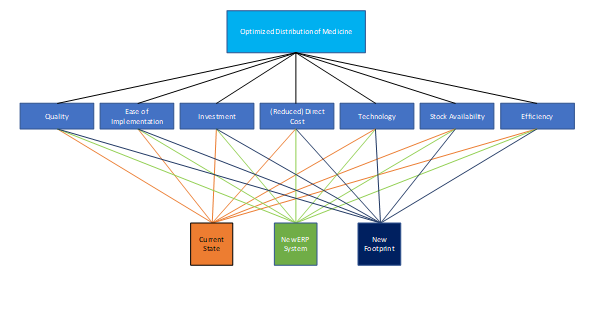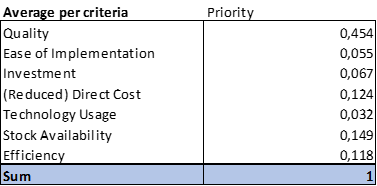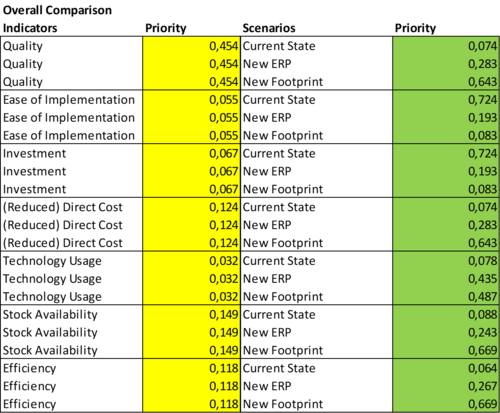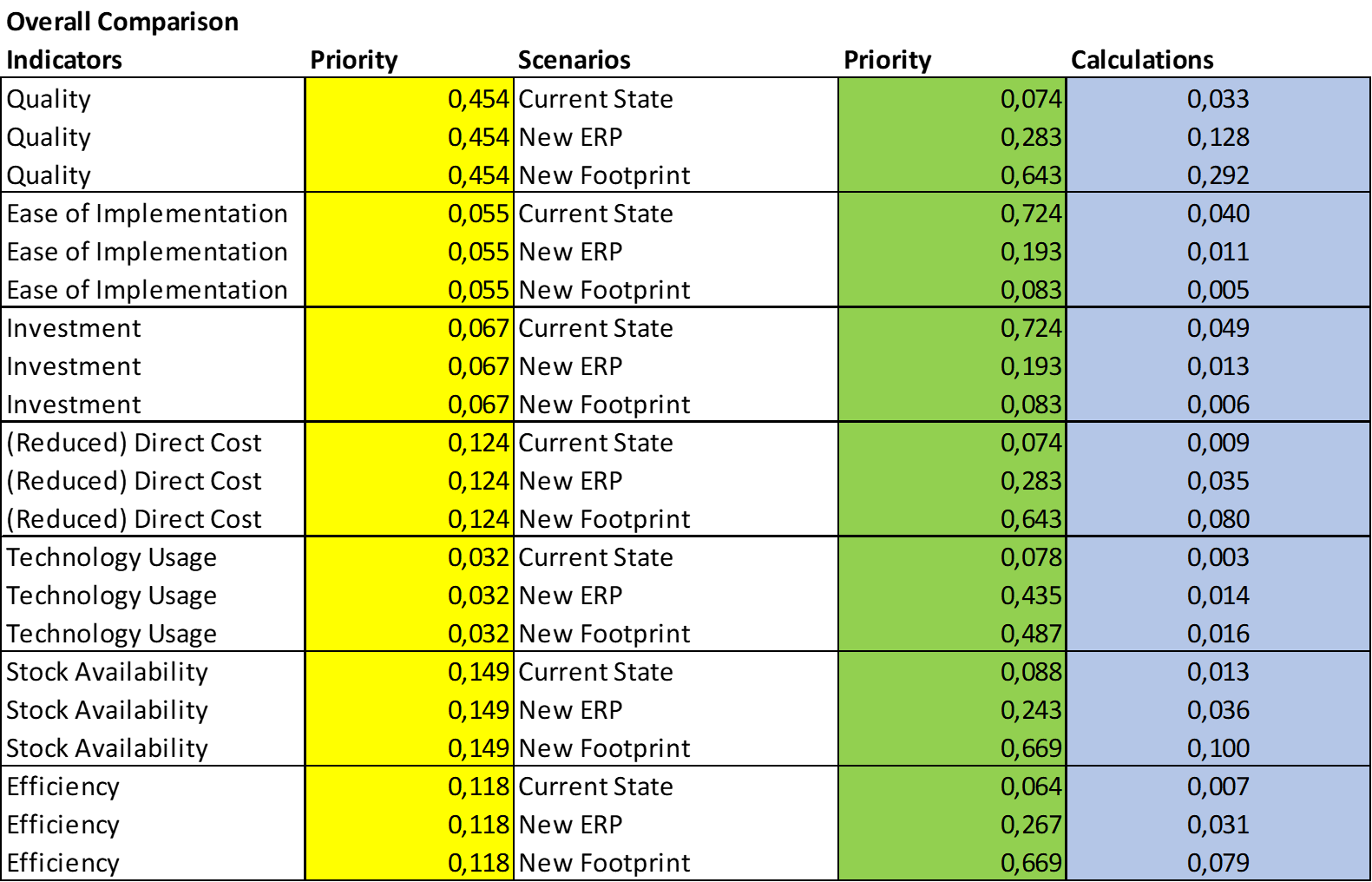Analytic Hierarchy Process
Contents
|
Abstract
This will be written in the end
Introduction
History
The Analytic hierarchy process is a multi-criteria decision making (MCDM) method (Ishizaka, 2009) utilized to analyse, solve and prioritize complex decision, by rating and comparing multiple criteria and scenarios against each other. It was Thomas Saaty, regarded as one of the pioneers of Operations research which developed the Analytic Hierarchy Process throughout the 1970s.
The objective of the method
The Analytic Hierarchy Method compares criteria, or alternatives with respect to a criterion in a pairwise manner (Forman, Exposition). Each criteria and alternative is rated, based on a predetermined scale which has shown to capture individual preferences with respect to quantitative and qualitative attributes (Saaty 1980, 1994, “from Forman”). The Analytic Hierarchy Method has been acknowledged for combining psychology and mathematics well in decision making (rewrite and find reference).
Methodology - A Step-By-Step approach
When applying the Analytic Hierarchy Process to a multi-criteria decision, there are some basic pre-defined steps that should be followed:
For better understanding of the Analytical Hierarchy Process an example has been made for better understanding of the practical usage of the method, highlighted after every step of the method. The example is derived from the theory, but created by the author of the article and based on a fictional case. The example is to consider improved scenarios for the medicinal distribution within a hospital.
Define the Problem
The decision making should be driven by a stated problem. The problem should be well defined and the objectives of the problem should be broadened to consider all actors, objectives and possible outcomes (Vaidy&Kumar, p2). All criteria that influence the solution, the chosen outcome, are then to be identified.
Example: Background and Definition of the problem
A consultant team has proposed two new solutions to improve the efficiency, quality and cost of distributing medicine towards the patients within a hospital. The hospital has a low level of technology, minimal usage of IT systems and the medicinal storage is spread out throughout the hospital.
The first solution proposes to implement a new IT solution, a so called ERP system, for improved quality and management of medicine. It is considered relatively investment light and easy to implement, but with low cost improvements. This solution will be referred to as the New ERP System solution.
The second solution proposes to radically change the storage solutions within the hospital. All storage units are to be combined in one large stocking area, with improved distribution combined with smaller stock supermarket solutions and distribution medicinal runners, which fill up the supermarkets daily. An all new ERP solution is proposed as a part of the solution. This solution has been simulated and showcases improved cost, efficiency and quality of distribution. It does though need considerable investment and it is harder to implement.
The two scenarios are to be proposed towards a steering committee within the hospital, which will have to decide what they want to do. The current state is also an option. The steering committee will use the Analytical Hierarchy Process (AHP) method to decide between the solutions.
The consultant team has proposed the following criteria that have to be considered when choosing a future solution:
a. Quality (quality of medicine distribution towards patience) b. Ease of Implementation (Easiness of implementing new solution) c. Investment (Cost of initial Investment) d. Direct Cost (Reduced cost of operations) e. Technology Usage (State of the art technology usage) f. Stock Availability (Transperancy of stock availability) g. Efficiency (Efficiency in terms of daily operations)
Define the Problem Hierarchy
The factors which effect the final decision are then arranged in an hierarchic structure. This serves two purposes:
1. It helps to structure the problem and thereby understanding the complex relations between all considered factors.
2. It helps the decision maker to visually assess whether the issues stated in each level in the hierarchy are at the same level of importance and magnitude. This is important so factors can be considered accurately and of similar manner.
The hierarchy is sorted from the overarching goal at the top, to criteria and eventual sub-criteria, and then lastly the possible alternatives that are to be considered. (saaty, 2002)
Example: Define the Problem Hierarchy
To start the process, the steering committee defines the hierarchy for the problem. The Distribution of medicine is defined as the overarching Goal, the pre-defined criteria shown below and lastly the three available solutions are defined as the alternatives. Each alternative has to consider each criteria in the hierarchy level above. The hierarchy is shown in the figure below.
Pairwise comparison and Calculate the Goal Priority
Pairwise comparison of attributes on each level based with a numerical rating, based on a pre-defined scale. Comparison matrices are constructed for each set of pairwise comparisons. This requires n(n-1)/2 comparisons, n defined as the number of attributes in consideration on each level. The rating scale for the pairwise comparison goes from 1 to 9, where if attribute A is of equal importance to attribute B, it receives a rating of 1. If attribute A is of absolute more importance than B, it receives a rating of 9. Likewise, if attribute A is considered absolutely more important than B, than attribute B should be rated with the reciprocal rating of A.
Based on the comparison matrices for each set, the priorities are obtained and utilized to weigh the priorities in the level below in the hierarchy. For each attribute, calculate the weighted value and obtain the overall global priority for the overarching goal.
Example: The Pairwise Comparison and Goal Priority
With the hierarchy in place, the weight of each criteria has to be considered. Each criteria is compared in a pairwise comparison utilizing The Fundamental Scale for Pairwise Comparisons, shown in figure x:
The comparison is done in a reciprocal matrix, with the size n x n. As there are 7 criteria, the matrix has to consider 49 values. The rating scale value is inserted for each pair comparison, read as row compared to column.
The Steering committee discusses each pair comparison and eventually comes to a conclusion, resulting in the table shown below:
To calculate the priority weight of each criteria, the table has to be normalized. This is done by dividing each rating with the sum of the given column. This resolves in the table shown below:
Lastly, to define the overall priority rating for each criteria, the average is calculated for each criteria. This results in the following table:
Consider how consistent the ratings are
After obtaining the main global priority for the overarching goal, it is important to consider how reliable the ratings are. The ratings are a pairwise comparison and can be subjectively bias, as they are based on individual or group perspectives towards each criteria. In psychology subjective bias is typically defined as Confirmation Bias, generally defined as the interpretation of evidence which is partial to ones existing beliefs and expectations. This bias can affect the overall solution, with certain criteria or alternatives weighing to much and thereby affecting the rating consistency (confirmation bias reference).
To address this, a consistency ratio is calculated utilizing a framework and a consistency index (CI) put forward by Saaty (1997). (Ishizaka&Labib, 2009, p5). A Principal Eigen Value is calculated, based on the global priority for each attribute. The sum of the Principal Eigen Values for all attributes are accumulated and divided with n, the number of attributes in the given hierarchy level. This gives a certain Inconsistency level. This Inconsistency level is then compared to the Consistency Index as proposed by Saaty, which is defined for each matrix of size n. The numerical value for each matrix of size n in the Consistency Index, has been calculated based on large samples of random matrices and the consistency indices of those matrices (Ch 1, AHP, p3). A Consistency Ratio is calculated, by dividing the Inconsistency level with the appropriate Consistency Index. If the Consistency Ratio is less than 0.1 (10%) than the matrix can be considered as being consistent. (Ishizaka, p5). If it is higher than 10% it is advised to reconsider the attribute rating to achieve consistent measures.
Example: Consistency in criteria Ratings
To make sure that the steering committee was consistent throughout their criteria weight ratings, the Consistency Ratio has to be calculated. The Consistency Ratio (CR) is calculated by dividing the Inconsistency Ratio (IR) with the Consistency Index (CI) which is pre-defined for each matrix of the size n. This is further explained in the step-by-step segment above.
First, the Principal Eigen Vector is needed. The Principal Eigen Vector is calculated by dividing the overall priority rating for each criteria with the sum of rating for each attribute column (will be explained better). The Principal Eigen Vector per criteria is as follows:
The Inconsistency Ratio is based on the sum of all Principal Eigen Vectors and the amount of attributes. The amount of attributes are defined as n, and the sum of the Principal Eigen Vectors as z. The formula to calculate the Inconsistency ratio is as follows: IR = (z-n)/(n-1) Based on the formula, this gives: (7,558-7)/(7-1) = 0.093
The Consistency Index is based on the amount of attributes n, defined in the following table:
As there are 7 criteria (attributes), n is equal to 7. Based on the table, that gives a Consistency Index (CI) of 1,32.
Lastly, the Consistency Ratio is calculated as follows:
CR = IR / CI --> 0.093/1,32 = 7%
As the Consistency Ratio falls under 10%, the criteria ratings are deemed to be consistent throughout the Matrix.
Example: Ratings per Alternatives
With the criteria in place, the solution alternatives have to be compared pairwise as well and rated. The procedure is similar, where each alternative pair is considered for each criteria.
An example for the first step of the Quality Criteria is showcased as follows:
As before the table is then normalized, the Principal Eigen vector is calculated and the Consistency Ratio. This is done for all 7 criteria, where all ratings have to be consistent with a Consistency Ratio below 10%. The overall priority ratings per criteria for each alternative is shown in the following table, highlighted in green:
As shown in the table, column highlighted in yellow, the Quality criteria is considered to have the highest priority while the Technology Usage criteria is considered be of the lowest importance
Example: Overall weight of alternatives
Lastly, the weight for each alternative within each criteria is calculated by multiplying the priorities with each other. The results are highlighted in blue, in the following table:
These priorities are than summed up an a matrix, where the sum of all criteria per alternative is calculated. The sum is the overall priority goal for the Optimized Distribution of Medicine, per alternative. The Goal priorities are shown in the following table, highlighted in gray:
As can be seen in the table, the New Footprint alternative is prioritized as the best solution with a Goal priority of 0.42 , based on all criteria and inputs for an optimized distribution of medicine within the hospital.
Perform a Sensitivity Analysis
Lastly, it is advised to perform a sensitivity analysis to observe the impact of modifying the input data towards the results. This is done by modifying the ranking of individual criteria as well the criteria weight towards the possible alternatives. If the global priority rank does not change, the results are considered to be robust. (Ishizaka, p 7).
Example: Sensitivity Analysis
The consultant team proposes that a simple sensitivity analysis should be made. The steering committee wants to consider if they weighed the Quality criteria to high compared to the Investment criteria. They have therefor increased the weight of the investment by 0.3 and decreased the weight of the quality criteria by 0.3.
This results in the following:
As can be seen for the overall goal priority, the New Footprint solution is still considered to be the optimal solution, with a Goal priority of 0.59 .
The Steering Committee and the consultant team feel confident in their consistent choices and rating considerations, and it is decided to go forward with the larger investment of an improved distribution footprint within the hospital.
Mathematical Background
Note: Consider to include explanation of the theoretical Mathematical Background
Application Areas
Improve on, to include more references than one.
The Analytical Hierarchy Process is possible the most widely utilized decision making method in the whole world. There are more than a 1000 articles regarding the method and over a 100 doctoral dissertations. (Forman, p 1)
The method has been used in a wide spread of areas within both the public and the private sector. An example of applications are as follows:
Choices involving the selection of one alternative from a set of alternatives, for example when investing in a new technological solutions, a new product for a new market, choosing a new supplier etc.
Prioritization or evaluation of alternatives. Rather than only choosing one alternative, a few alternatives can be highlighted as the best ones. This could be relevant, for example if a company wants to consider a combination of alternatives.
Resource allocation, for example budgeting for an array of multiple projects and defining which projects to prioritize and invest in.
Limitations
Note: Here I will explain about the limitations utilizing the method: a. It quite qualitative and subjective b. There have been some considerations regarding the pre-defined scale











